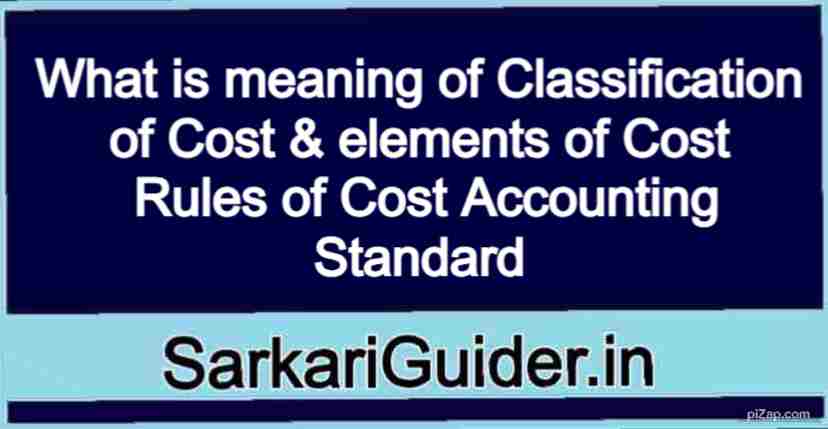
What is meaning of Classification of Cost & elements of Cost
Meaning of Classification & elements of Cost- A classification has to be made to arrive at the detailed costs of departments, production orders, jobs or other cost units. The total cost of production can be found without such analysis. and in many instances an average unit cost could be obtained but none of the advantages of an analyzed cost would be available.
Simple ascertainment of total cost cannot satisfy the various requirements of decision making. For effective control and managerial decision making, data is to be provided on the basis of analyzed and classified costs. In order to satisfy this objective. cost is analyzed by elements of cost i.e., by nature of expenditure.
Meaning of Elements of Cost – Costs are classified primarily according to the factor which expenditure is incurred.
(1) What is Material
(2) Meaning of Labor
(3) Expenses of Cost
1. What is Material – The substance from which the product is made is known as material. It may be in a raw or a manufactured status. It can be direct as well as indirect.
(a) What is Direct material –
Direct material are those materials which enter into and becomes integral part of the finished product. In other words, all known as direct material the wood furniture, the clay in bricks, the leather materials which can be identified with a particular product, job or process are in shoes.
sugarcane for sugar, cloth for readymade garments etc. Packing is also an item of direct material According to C.A.S-1 “Material cost is the cost of maternal of any nature used for the purpose of production of a product or a service”.
Thus direct material includes:
(i) All material specially purchase for a particulars products.
(ii) All primary packing materials card board boxes, wrappings cartoons, cigarette’s packet etc. The cost of direct material is known as direct material cost.
According to C.A.S-1 Material cost which can be allocated to cost centers or cost units
(b) What is Indirect material
Indirect material are those materials which cannot become as part of the finished product. In other words, all materials which cannot identified with a particular product or job or process are known as indirect material fuel, lubricating oil, waste, printing and stationery material etc.
According to C.A.S-1, Indirect material cost means material cost which cannot be allocated hut while can be apportioned, to or absorbed by cost centers or costs units.
2. What is Labor cost
For conversion of materials into finished product. human effort is needed, such human effort is called labor.
According to C.A.S.1, Labor cost is the cost reaeration wages, salaries, commission, bonus etc. of the employees of an undertaking. Labor can be direct as well as indirect.
(a) What is Direct labor cost
Labor which takes an active and direct part in the production of a particular commodity is called direct labor Direct labor costs are, therefore, specifically and conveniently tracible to specific products.
For example, in a printing press the wages paid to compositors would be direct to the job since the jobs for which the payment is being made can be easily identified.
The wages paid to such workers are known as direct wages or manufacturing wages or direct labor cost.
(b) What is Indirect labor cost
Labor employed for the purpose of carrying out tasks incidental to production of goods or those engaged for office work and selling distribution activities are known as indirect labor Wages payable to storekeeper. general indirect labor such as inspectors, supervisors.
wages for maintenance worker such as workshop cleaners. mechanics are all example of indirect labor According to C.A.S.1., Indirect wages which cannot be allocated but which can be apportioned or absorbed by cost centers or cost units.
(3) What is Expenses of cost
All expenditure other the material and labor are termed as expenses. It may direct or indirect.
(a) What is Direct expenses of cost
Direct expenses are those types of expenditure which are specifically incurred for doing a particular work or service or identified with a particular product or job process.
These are also known as chargeable expense. It includes all direct expenses other than direct material or direct labored.
(i) Production royalties, patents and copyrights etc.
(ii) Special tool expenses exclusively incurred for the products etc.
(iii) Fees paid to architects, surveyors, consultants etc. specific to the job etc.
(iv)Expenditure incurred on patterns, models, designs, drawing, special layout, experimental jobs exclusively relating to product or job or process.
(v) Excise duty.
(vi) Primary packing material means the saleable articles is not complete without a package or container e.g. cigarettes. matches and canned goods.
(b) What is Indirect expenses of cost
Expenses which cannot be charged to a product or job or process directly and which are neither indirect material nor indirect labor are regarded as indirect expenses. Examples are rent, rates and taxes. insurance, power, lighting and heating, depreciation, welfare and medical expenses etc.
What is cost | cost classification and its rules as per Cost Accounting Standard (CAS) 1 issued by The Cost Accountants of India
What is Meaning of Cost –
Cost is a sacrifice of resources to obtain a benefit or any other resource. As per Para 4.1 of Cost Accounting Standard-CAS. “Classification of Cost”: Cost is a measurement, in monetary terms, of the amount of resources used for the purpose of production of goods or rendering services.
What is Classification of Costs
Practically speaking. Costs can be classified in many different ways. It is necessary to be able to classify all costs. that is, to be able to arrange them into logical groups, in order to devise an efficient system to collect and analyze the costs.
The classification groupings wills depend on the purpose of the classification exercise.
As per Para of C.A.S-1 by Nature of Expense Cost should be gathered together in their natural groupings such as materials. labor and other expenses. Items of costs differ on the basis of their nature.
The elements of cost can be classified in the following three categories:
(i) Material Cost is the Cost of material of any nature used for the purpose of production of product or service. Material cost includes cost of procurement.
Freight inwards, taxes and duties, insurance etc. directly attributable to the acquisition Trade discounts, rebates duty drawbacks. Refund on account of MODVAT CENVAT, sales tax other similar items are deducted in determining the cost materials.
(1) Labor Cost means the payment made to the employees. permanent or temporary, for their services. Labor cost include salaries and wages paid to permanent employees, temporary employees and also to employees of the contractor.
Here, salaries and wages include all fringe benefits like gratuity, ESI overtime, incentive, bonus, ex-gratia, leave encashment, wages for holiday and idle time etc.
(iii) Expenses are other than materials cost or labor cost which are involved in an activity. Expenditure on account of utilized payment for bought out services, job processing charges etc., can be termed as expenses.
2. What is Relation of Cost Centre
As per this, cost can be classified into-
(a) Direct Cost- It is of 3 types
(i) Direct material Cost is the cost of material which can be directly allocated to a cost center or a cost object on an economically feasible way.
(ii) Direct Labor Cost is the cost of wages of the those workers who are readily identified or linked with a cost or cost object.
(iii) Direct Expenses are the expenses other than direct materials or direct labor which can identified or linked with the cost center or cost object.
(b) Indirect Cost- It is of three types:
(i) Indirect Materials is the cost of materials which cannot be directly allocated to a particular cost center or cost object.
(ii) Indirect labor cost is the wages of the employees which are material or labor and cannot be directly allocable to a particular cost centers.
इसे भी पढ़े…
- Definition of Primary Distribution of Overheads
- What is Re-Apportionment of Service Departments Overheads
- Process of Classification of Overheads | Basis of Overhead Classification
- What is Overheads | Bases For Allocation of Expenses to Departments
- What is Meaning of Incentive Wage Method | Methods of Wage Payment
- Meaning of Collection Allocation | Apportionment of Overhead Expenses
- What is Primary Distribution of Overheads
- What is Meaning of Overhead | Classification of Overhead
- Process of Classification of Overheads | Basis of Overhead Classification
- Advantages of Fixed and Variable Overheads | Difference Between Fixed & Variable Overheads
- What is Absorption of Selling and Distribution Overheads
- What is Money, Definition, Functions and various kinds of Money
- What is Apportionment of Overheads, Principles, Difference






